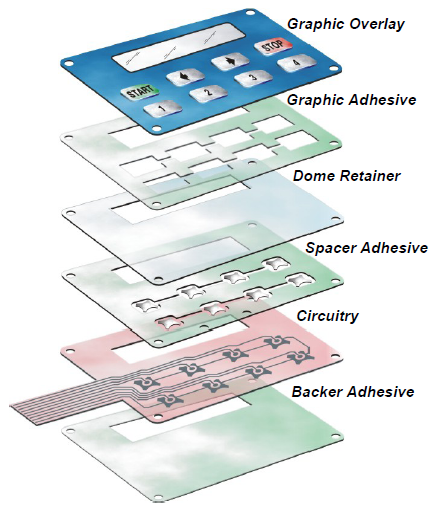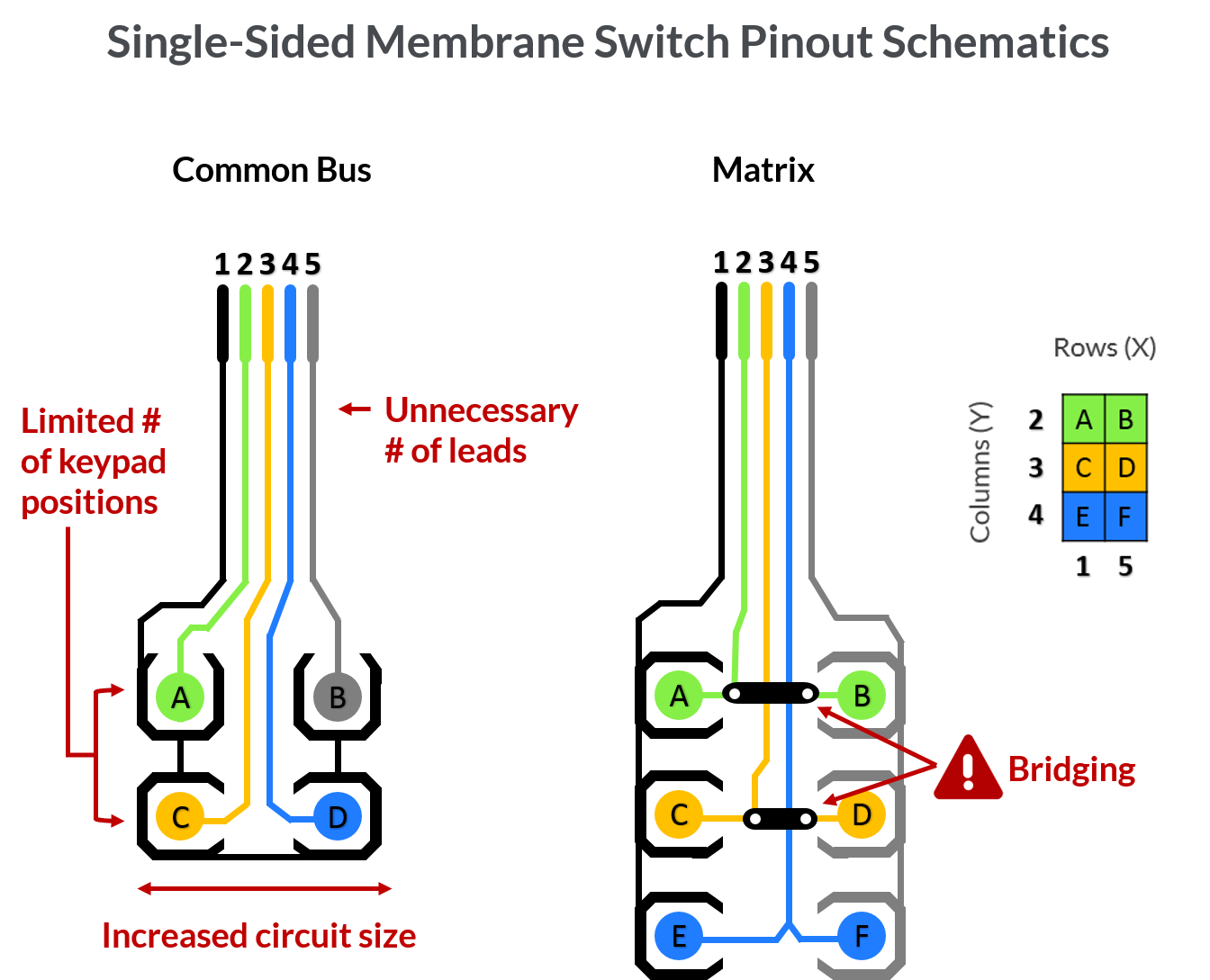The complete guide about membrane switch customization
Wiki Article
The Production Process Behind Membrane Layer Switch: What You Need to Know
The manufacturing procedure behind membrane layer changes combines careful style, product selection, and quality assurance. It starts with recognizing the complexities of membrane switch style and proceeds through numerous stages, consisting of material options and printing methods. Each stage plays a vital duty in ensuring performance and durability. However, the complexities of layer building and the extensive testing criteria might expose insights that are not quickly apparent. What lies past these foundational aspects?Understanding Membrane Switch Over Design
Membrane buttons might appear basic at first look, their design includes detailed factors to consider that guarantee performance and durability. The design process begins with a comprehensive understanding of individual needs, consisting of the user interface's intended application and environmental elements. Functional designs is a vital element, as the layout should assist in simplicity of usage while making certain that responsive comments fulfills customer expectations.Moreover, the layering of parts, such as visuals overlays, adhesive layers, and conductive traces, must be exactly engineered. membrane switch. This split setup not only influences the switch's responsiveness but also impacts its long life. Focus is offered to the securing strategies utilized to secure against moisture and dust, which could endanger efficiency. Furthermore, style considerations reach looks, where shade schemes and visual quality improve individual experience. Ultimately, the design of membrane layer changes balances capability, individual experience, and toughness, making sure that they satisfy the demands of numerous applications successfullyMaterials Made Use Of in Membrane Layer Switch Production
When choosing materials for membrane button manufacturing, it is important to ponder both performance and resilience. The key materials include polyester and polycarbonate films, which provide versatility and stamina. These movies are commonly coated with sticky to guarantee appropriate bonding to substrates. Conductive inks, commonly made up of silver or carbon, are important for producing electric connections within the button, permitting trusted operation.Additionally, a protective layer, such as a tough layer, is regularly applied to improve scrape resistance and longevity. The choice of backing product, such as acrylic or foam, can significantly influence the switch's tactile feeling and total user experience. In addition, numerous environmental aspects, consisting of temperature and humidity, ought to lead material choice to guarantee peak efficiency in particular applications. Eventually, the appropriate mix of materials adds to the membrane button's functionality and lifespan, making notified options necessary for manufacturers.The Printing Process: Creating Graphics and Text
The printing procedure in membrane layer button production plays a substantial duty in generating top quality graphics and text. Different visuals layout strategies are used to assure aesthetic allure and functionality, while cautious ink choice techniques are necessary for longevity and efficiency. Recognizing these aspects is basic for achieving best outcomes in membrane layer button style.Graphic Design Techniques
Graphic style strategies play an essential duty in the printing procedure of membrane buttons, as they specify just how graphics and message will ultimately show up on the final item. Efficient graphic layout includes the strategic use font styles, formats, and colors to boost readability and visual allure. Designers often use vector graphics for scalability, guaranteeing that photos continue to be sharp at different dimensions. Additionally, focus to contrast and positioning is vital, as it influences individual communication and visual high quality. The unification of branding elements, such as logos, must be managed with treatment to keep brand name integrity. Generally, thoughtful visuals design methods add considerably to the performance and attractiveness of membrane buttons, impacting customer experience and item performance.Ink Choice Approaches
Picking the appropriate ink is essential for attaining the desired visual high quality and longevity in membrane switch manufacturing. Numerous ink kinds are utilized, including solvent-based, water-based, and UV-curable inks. Each type provides unique features, such as resistance, flexibility, and adhesion to environmental elements. Solvent-based inks are typically preferred for their longevity and vivid shades, while water-based inks are extra eco pleasant yet might have constraints in attachment. UV-curable inks supply fast treating and robust performance. Additionally, color matching techniques ensure that the picked inks straighten with layout specs. Ultimately, the selection of ink must consider aspects such as application technique, substrate compatibility, and end-use requirements to achieve superior outcomes in membrane switch graphics and message.Layer Building And Construction and Setting Up

Material Selection Process
A cautious choice of products is crucial in the production process of membrane layer switches, as it directly influences functionality and sturdiness. The main materials utilized include polyester, polycarbonate, and different conductive inks. Polyester is commonly favored for its excellent resistance to chemicals and abrasion, making it suitable for severe atmospheres. Polycarbonate, on the other hand, provides exceptional quality and effect resistance, which is valuable for applications calling for presence and effectiveness. Conductive inks, commonly made up of silver or carbon, are essential for creating trusted electric paths. Furthermore, the choice of adhesive products influences the general stability of the switch - membrane switch. Examining variables such as ecological exposure, tactile responses, and visual demands guides suppliers in picking the very best products for their specific applicationsLayer Attachment Methods
Adhering layers in membrane layer switch building is a vital procedure that ensures performance and longevity. Numerous bond techniques are used to secure ideal bonding in between layers, which normally include using adhesives, warm, and pressure. Pressure-sensitive adhesives (PSAs) are generally used for their convenience of application and instant bonding capabilities. Furthermore, thermal bonding strategies can be applied, where warmth is utilized to turn on sticky residential properties, securing a solid bond. The choice of bond approach mainly relies on the materials included and the specific application demands of the membrane layer switch. Correct alignment and uniform application of adhesives are essential to stop defects, safeguarding the switch runs effectively throughout its designated life-span.Quality Assurance Measures
Ensuring quality assurance during the layer building and setting up of membrane layer switches is necessary for keeping performance and dependability. This procedure typically includes a number of essential measures, including detailed inspections at each stage of production. Makers utilize innovative testing techniques, such as peel tests and bond analyses, to validate the honesty of layer bonds. Additionally, visual inspections are carried out to determine any type of flaws in printing or product incongruities. Ecological problems, such as temperature level and moisture, are meticulously checked to assure ideal curing and adhesion. Regular calibration of devices assists preserve internet accurate manufacturing standards. By implementing these quality assurance measures, manufacturers can greatly lower the threat of item failure, assuring that the final membrane changes fulfill the called for specs and consumer assumptions.Checking and High Quality Control Steps

Technologies in Membrane Change Technology
As advancements in modern technology proceed to develop, membrane buttons are gaining from cutting-edge advancements that enhance their capability and individual experience. One notable technology is the combination of capacitive touch technology, which enables more receptive and user-friendly interface. This shift not just enhances visual appeals yet likewise lowers mechanical deterioration, expanding the life expectancy of the switches.Additionally, advancements in graphic overlay products have caused improved longevity and resistance to environmental aspects such as moisture and UV light. These materials currently offer improved quality and brightness, further boosting the visual appeal.Furthermore, the consolidation of clever technology is transforming membrane layer switches over into interactive control panels, making it possible for connectivity with IoT devices. This connectivity cultivates a seamless user experience, paving the means for applications in numerous industries, from health care to customer electronic devices. Collectively, these developments setting membrane layer switches over as crucial elements in contemporary tool layout.Frequently Asked Concerns
Exactly how Lengthy Does the Membrane Layer Switch Over Production Refine Take?
The duration of the membrane switch manufacturing process can vary significantly. Aspects such as intricacy, products made use of, and manufacturing quantity influence timelines, with common production ranging from a few days to a number of weeks for conclusion.What Are the Common Applications for Membrane Buttons?
Membrane buttons are commonly utilized in various markets, consisting of auto controls, household appliances, medical gadgets, and consumer electronic devices (membrane switch). Their adaptability and longevity make them ideal for applications requiring user-friendly user interfaces and trustworthy efficiency in diverse environmentsCan Membrane Switches Be Customized for Details Demands?

What Is the Life-span of a Common Membrane Layer Switch?
The life expectancy of a regular membrane button differs, but usually, it ranges from 1 to 5 million cycles. Aspects such as usage, setting, and material top quality greatly affect resilience and general efficiency over time.

Are Membrane Layer Switches Over Eco-friendly?
The ecological kindness of membrane switches differs. Some materials made use of might not be recyclable, while others can be environment-friendly. The overall impact depends upon producing practices and products, necessitating careful factor to consider throughout choice and disposal. The manufacturing procedure behind membrane layer changes combines careful layout, product selection, and high quality control. It begins with understanding the intricacies of membrane layer switch design and proceeds with various stages, consisting of material selections and printing techniques. When picking materials for membrane layer button production, it is essential to ponder both performance and resilience. A mindful choice of materials is crucial in the manufacturing process of membrane layer switches, as it straight influences capability and toughness. The choice of attachment method greatly depends on the materials entailed and the particular application requirements of the membrane button.Report this wiki page